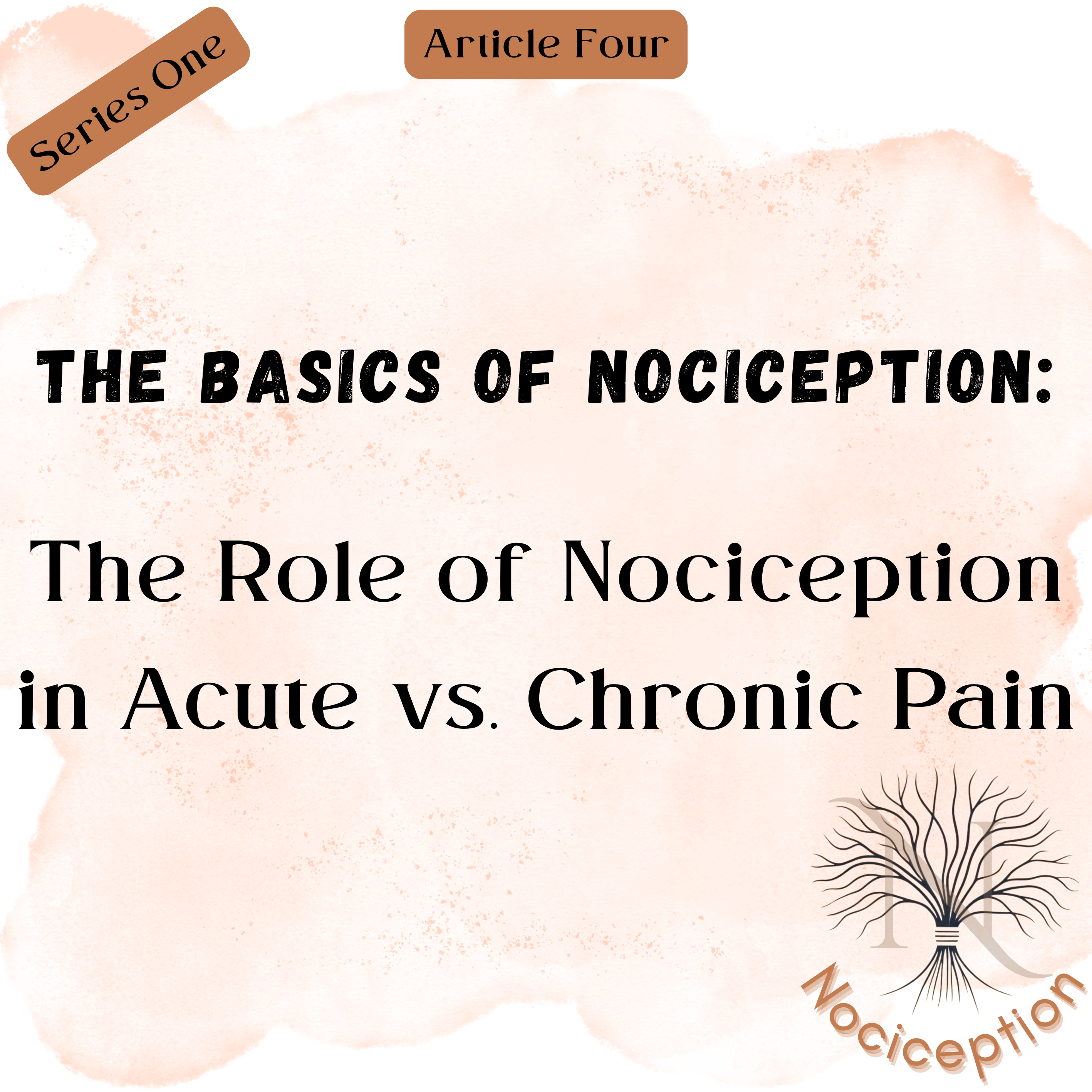Nociception is the body’s response to harmful stimuli, and understanding how it functions differently in acute and chronic pain can give us greater insight into pain management. In this article, we’ll explore how nociceptive pathways contribute to both acute and chronic pain, the difference between these types of pain, and how nociception impacts each one.
As always – make smart choices and do not base them purely an article on the internet no matter how well researched it may be – disclaimer in the side bar.
Understanding Pain
Before diving into how nociception plays a role in acute and chronic pain, it’s essential to understand the basic concepts of pain itself. Pain is a complex experience involving both physical sensations and emotional reactions. It begins when nociceptors—specialized sensory neurons—detect harmful stimuli. This sensory information is sent to the brain for processing, resulting in the sensation of pain.
Pain can be classified into two broad categories: acute pain and chronic pain. Acute pain is typically a short-term response to an injury or tissue damage, signaling the body to protect itself. On the other hand, chronic pain persists even after the initial injury has healed and may become a more complex issue involving the central nervous system.
The difference between acute and chronic pain is not just in how long the pain lasts, but also how the brain processes and reacts to pain signals. While acute pain usually serves as a protective mechanism, chronic pain can become maladaptive, affecting a person’s quality of life long after the injury or condition causing the pain has healed.
In this section, we’ll look at how nociception fits into the broader picture of pain, and how its pathways function differently in acute vs. chronic pain. Understanding this difference can help guide effective treatment options.
The Nociceptive Pathways in Acute and Chronic Pain
The nociceptive pathways involve a series of steps that transmit pain signals to the brain. These steps play a role in both acute and chronic pain, but the way the body processes these signals changes depending on the type of pain.
Acute Pain Pathways
Acute pain is the body’s immediate response to harmful stimuli. When you touch something hot or step on a sharp object, your nociceptors send signals through the spinal cord to the brain. This pain helps you react quickly—removing your hand from the heat source or lifting your foot off the sharp object. Acute pain is typically short-lived and resolves once the tissue heals or the harmful stimulus is removed.
In terms of nociceptive pathways, acute pain is often associated with the first-order afferent neurons that carry signals directly from the site of injury to the spinal cord and then to the brain. The body’s response is quick, usually accompanied by a release of substance P and other chemicals that heighten sensitivity to pain in the affected area, ensuring the body reacts immediately.
Chronic Pain Pathways
Chronic pain, however, involves a more complex and sometimes dysfunctional response from the nervous system. Instead of healing, pain signals continue to be sent to the brain, even when there’s no ongoing tissue damage. This phenomenon can occur due to sensitization, where the nervous system becomes overly sensitive to pain stimuli. This means that pain can feel more intense and last much longer than it should.
In chronic pain, central sensitization occurs, where pain signals continue to be processed by the brain even when there is no immediate threat. This can happen due to injury or disease that alters the way the nervous system responds to pain. In some cases, the brain becomes “rewired” to perceive pain more acutely, even without a direct stimulus.
The Intersection of Acute and Chronic Pain
While acute pain is a protective, short-term response, chronic pain may become a condition of its own, deeply affecting the nervous system and requiring different management strategies. Understanding how nociception works in each scenario can help inform appropriate treatment strategies, from medications to physical therapy and beyond.
In acute pain, treatments often focus on reducing inflammation and preventing further injury, while chronic pain treatments might include therapies that address the underlying neural changes or manage pain perception in the brain.
By exploring how nociceptive signals function in both acute and chronic pain, we can begin to appreciate the complex role nociception plays in our daily lives.

Practical Takeaways: Coping with Acute and Chronic Pain
Understanding the role of nociception in both acute and chronic pain allows us to approach pain management with a more informed mindset. While acute pain serves as a protective signal, chronic pain can become a lasting problem that needs specialized care. Techniques like mindfulness, physical therapy, and even pharmacological treatments are often used to manage chronic pain and improve quality of life.
For further reading on nociception and its role in pain, check out these articles:
The Basics of Nociception Series:
1) What Is Nociception? An Overview of Pain Signaling
2) How the Nervous System Detects Pain: Key Mechanisms
3) Nociceptors Explained: The Body’s Pain Sensors
4) The Role of Nociception in Acute vs. Chronic Pain (CURRENT ARTICLE)

No Responses